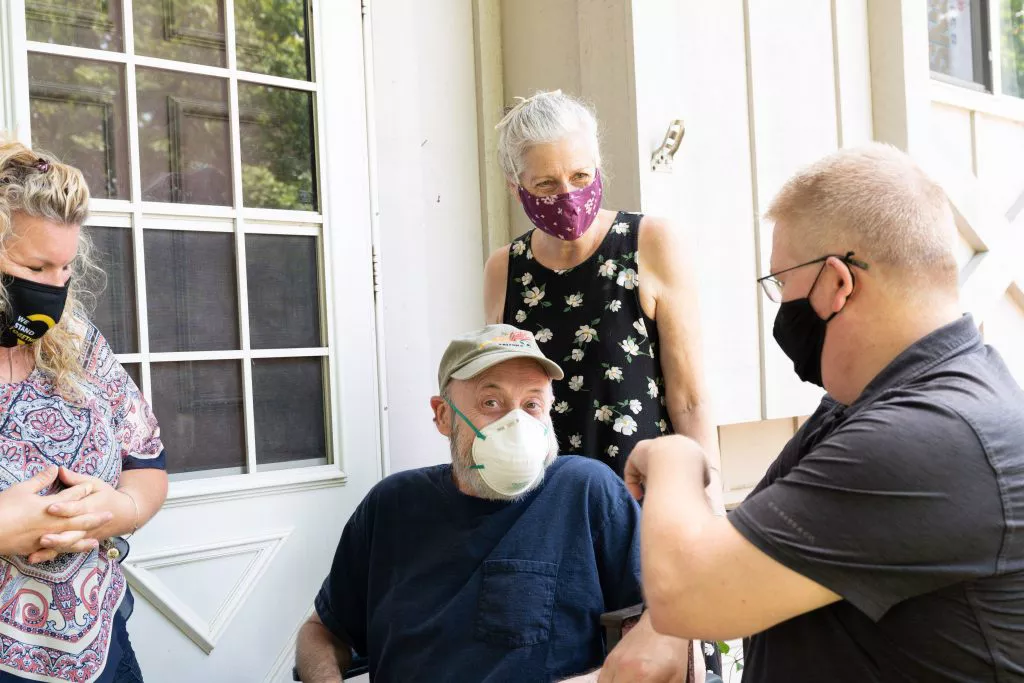Steve Hayes: A second—and third—chance at life

Steve Hayes knows he wouldn’t be alive today if not for two quick-thinking co-workers and dozens of caregivers.
“Thank you for saving my life,” the Environmental Services housekeeper says to all those who cared for him at UI Health Care.
On April 1, Hayes had just gotten off second shift at UI Hospitals & Clinics.
“To be honest, I don’t even remember going out into a parking ramp,” says Hayes. “Luckily, some people were with me, otherwise I don’t think I’d be here today.”
Hayes’ co-workers, Kathy Keifer and Dorothy Guise, saw him fall and hit his head. They ran back into the building for help.
“I was on patrol around the first-floor area of the hospital when I was dispatched to a person down in the lobby of Ramp 1 elevator with a possible head injury,” says Kent Andersen, security specialist.
Andersen joined Lara Berkenpas, nursing assistant, who was already working on Hayes.
“I had grabbed gloves and run to the Ramp 1 elevator lobby where I found Steven blue, no pulse, and no respiration,” she recalls. “Kent brought the defibrillator and took over chest compressions as I provided breaths. Kent’s unwavering character and know-how are top notch.”
The Johnson County Ambulance arrived and transported Hayes to the Emergency Department.
“It was a great team effort by all,” says Andersen.
A call in the middle of the night
Hayes doesn’t remember anything from that night. But his wife, Angie, remembers it all.
“I got a phone call about two in the morning; I was sound asleep,” says Angie. “It was a social worker at the university who told me (Steve) was taken to the emergency room because he had collapsed.”
Looking back, she can see a silver lining in COVID-19.
“The only, I guess, good thing about the virus is that everybody has to enter and exit from the same door,” she says. “[Kent and Lara] ran back, and he was parked in parking ramp one, which is really close to the front door. They’re the ones who really saved his life.”
After she arrived at the hospital, Angie says Hospital Security Officer Howard Dean took care of her and that Andersen and Berkenpas checked in on both she and Steve.
The care and compassion she and her husband received at UI Health Care was only beginning.
Another brush with death
Hayes was placed into an induced coma in the intensive care unit. Doctors wanted to determine what caused his attack, so they scheduled him for further tests. On the way to an angiogram, Steve coded again in the hallway by the elevator.
“One of the cardiac doctors just happened to be walking down the hall,” says Angie. “He saw the nurse and respiratory therapist trying to revive Steve and joined them.”
Team members worked on Hayes for 10 minutes. He survived. But no one was sure if he’d have brain function.
“Dr. Brian Gehlbach told me later, ‘Coding two times is not promising for brain recovery,’” says Angie.
And his heart issues remained a mystery: his echocardiograms were strong, and he didn’t have a blockage in his heart. In the end, UI Health Care doctors determined Steve had had an electrical malfunction with his heart rate.
“Mr. Hayes’ situation was unusual in that he didn’t have any prior history of heart disease or heart problems,” says Denice Hodgson-Zingman, MD, cardiac electrophysiologist. “We recommended he have an automatic defibrillator implanted. Four months later, the implanted defibrillator has not detected any further abnormal rhythms, but is constantly monitoring his heart and ready to provide a life-saving therapy should he need it.”
Faint memories
Steve remembers only bits and pieces about his stay in the intensive care unit.
“The whole time I was unconscious, I was kind of in a dream state,” says Steve. “I thought I was at work. And I was trying to get out of my bed and set off alarms.”
His care team carefully monitored his physical and mental state. Angie, his wife of 44 years, remained hopeful.
“Even when he was delirious, he knew the names of our kids,” says Angie. “And he knew me. He couldn’t say much, but he could still tell me he loved me, which got me through.”
Angie continued sleeping at the hospital, taking medical notes, and keeping their son and daughter updated on Steve’s progress.
“Our son made him a playlist and I was playing music for him, because he was starting to come around,” says Angie. “When he was transferred to the cardio unit, I told a couple of the nurses that he was a drummer. So, they let me bring his sticks and a drum pad.”
Jason Eness, one of the cardiac nurses, played YouTube videos featuring Steve on some of the albums he’d recorded.
Home sweet home
As Steve slowly improved, he was cleared for release and spent more than two weeks in rehab, followed by seven weeks in skilled care. Since early July, Steve has been recovering at home. He has follow-up appointments at UI Hospitals & Clinics and will begin outpatient physical therapy here, too.
At home, Steve uses a walker and wheelchair. He still has trouble with some word recall and short-term memory, but given the medical concerns about brain damage, he is doing incredibly well.
“There are just some slight moments where a word won’t come back to me maybe until I think of something else, and then boom, there it is,” he says. “It just pops up.”
As he looks back on his medical journey, Steve is grateful to all those who helped him and is happy he’s alive to enjoy his first grandchild.
“From where I started to where I am now? I can’t even begin to describe how much my condition has improved,” he says. “I mean, it’s amazing.”